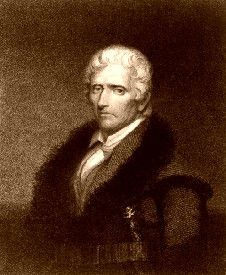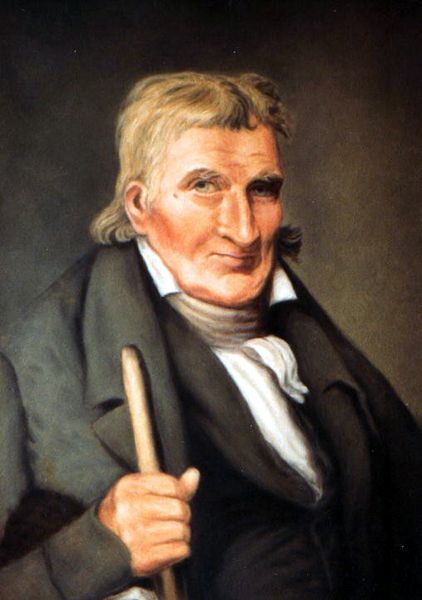Simon Kenton was a legendary frontiersman and soldier in West Virginia, Kentucky, and Ohio. Kenton was born on April 3, 1755, in Fauquier County, Virginia, to Mark Kenton, Sr., an immigrant from Ireland, and Mary Miller Kenton, of Scots-Welsh descent. Helping on the family farm while growing up, he had little opportunity to go to school and would remain illiterate for his entire life, only learning to sign his name.
In 1771, when he was 16 years old, he became involved in a jealous fight involving a woman. Believing he had killed a man, he fled into the wilderness of West Virginia, Kentucky, and Ohio, where for years, he went by the name “Simon Butler.” He learned to adapt and survive in the wilderness.
A big man in stature and strength, his stamina was often tested as he endured the worst known to the frontier. During the late winter of 1773, Simon and two companions were attacked around the campfire while drying their wet clothes near present-day Charleston, West Virginia. One companion was killed, while Simon and the other man barely escaped without food, clothing, or rifles. After a week of wandering down the Great Kanawha River, suffering from hunger and exposure, they finally reached the Ohio River, where they met some mountain men. After recovering, Kenton then spent time hunting along the Ohio River and searching for the legendary Canelands along the Ohio River that he had heard so much about.
In 1774, he served as a scout for the European settlers against the Shawnee Indians during Lord Dunmore’s War in West Virginia and Kentucky.
By 1775, Kenton had moved to Boonesborough, Kentucky. For the next few years, he worked as a scout for the settlement, often coming in contact with the local American Indians.

Daniel Boone
In April 1777, during an Indian attack on Fort Boonesborough in Kentucky, a bullet struck Daniel Boone’s leg, and he found himself staring up at a Shawnee tomahawk. Kenton charged, shot the scalper, and clubbed another attacker, then lifted Boone in his arms and carried him, dodging and darting, to safety. “Well, Simon, you have behaved like a man today,” Boone told him; “indeed, you are a fine fellow.”
Kenton participated in several military engagements against the British and their American Indian allies during the American Revolution. In 1778, he joined George Rogers Clark on a challenging but successful expedition into the Illinois Country to attack British outposts and Indian settlements. Returning home, he accompanied Daniel Boone in an attack on the Shawnee settlement of Chillicothe near Oldtown, Ohio.
In September 1778, while on a spying mission in Chillicothe (near Xenia, Ohio), Kenton was captured by Shawnee Indians. He was forced to run the infamous quarter-mile “gauntlet” while being beaten with sticks by two lines of Indians. This ritual often killed many prisoners, but Kenton survived it nine times. Severely wounded after this and other ritual tortures, he was saved by his long-time friend Simon Girty who convinced the Shawnee to adopt Kenton as one of their own. The Shawnee respected Kenton for his endurance, and they named him Cut-ta-ho-tha (the condemned man).
Finally, in June 1779, Simon was sent to Fort Detroit as part of a prisoner trade with the British. He was soon freed and returned to service under George Rogers Clark.
In 1782, he discovered that the man he thought he had killed in Virginia had lived, and he took back his original surname.
Kenton started exploring the area of the Mad River Valley of Ohio and making claims as early as 1788. Kenton first saw the area a decade before while he was held as a prisoner with the Shawnee and vowed that if he survived, he would return.
During the next several years, Kenton lived a relatively quiet life. He settled near Maysville, Kentucky, where he married Martha Dowden and purchased large tracts of land. The couple would have four children together.
In 1793-94 Kenton fought in the Northwest Indian War with “Mad” Anthony Wayne and at the Battle of Fallen Timbers.
After Kenton’s wife died in a house fire, the widower married Elizabeth Jarboe in 1798 and moved to Ohio. He had six children with her. They lived near present-day Springfield.
In April 1799, Kenton and his associate, Colonel William Ward, led a group of families from Mason County, Kentucky, to an area between present-day Springfield and Urbana, Ohio.
In 1810 Kenton moved to Urbana, Ohio, where he achieved the rank of brigadier general of the state militia. He served in the War of 1812 as a scout and leader of a militia group in the Battle of the Thames in 1813. This was the battle in which the famous Indian chief Tecumseh was killed. Kenton was chosen to identify Tecumseh’s body, but, recognizing both Tecumseh and another fallen warrior named Roundhead and seeing soldiers gleefully eager to carve up Tecumseh’s body into souvenirs, he identified Roundhead as the chief.
Kenton moved to the Zanesfield, Ohio, area around 1820. During the last years of his life, Kenton lived in poverty because of land ownership disputes and mismanagement of his money. He survived on a government pension of $20 a month. In 1836, Kenton died in Logan County and was initially buried at New Jerusalem. In 1865, his remains were moved to Urbana. The state of Ohio constructed a monument to mark his grave in 1884.
© Kathy Alexander/Legends of America, updated January 2023.
Also See:
Soldiers & Officers in American History
Kentucky – The Blue Grass State
Sources:
Friends of the Frontier
Ohio Central History
USA Today
Wikipedia

